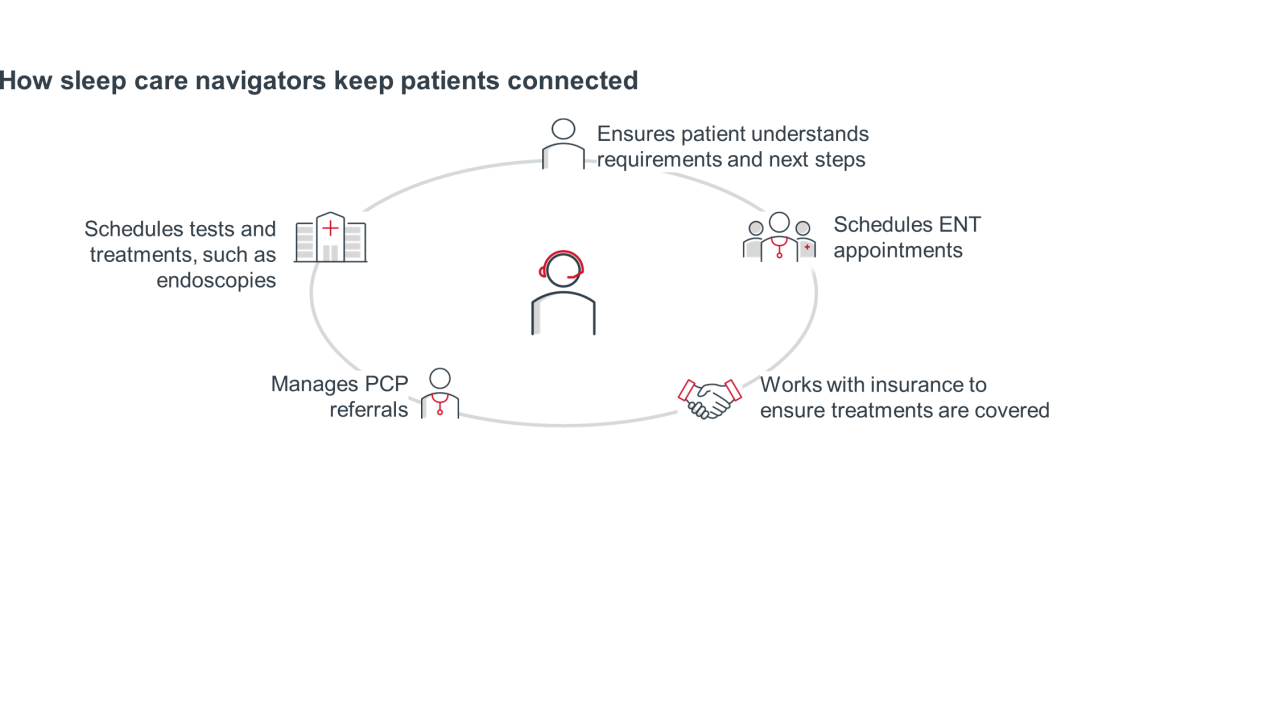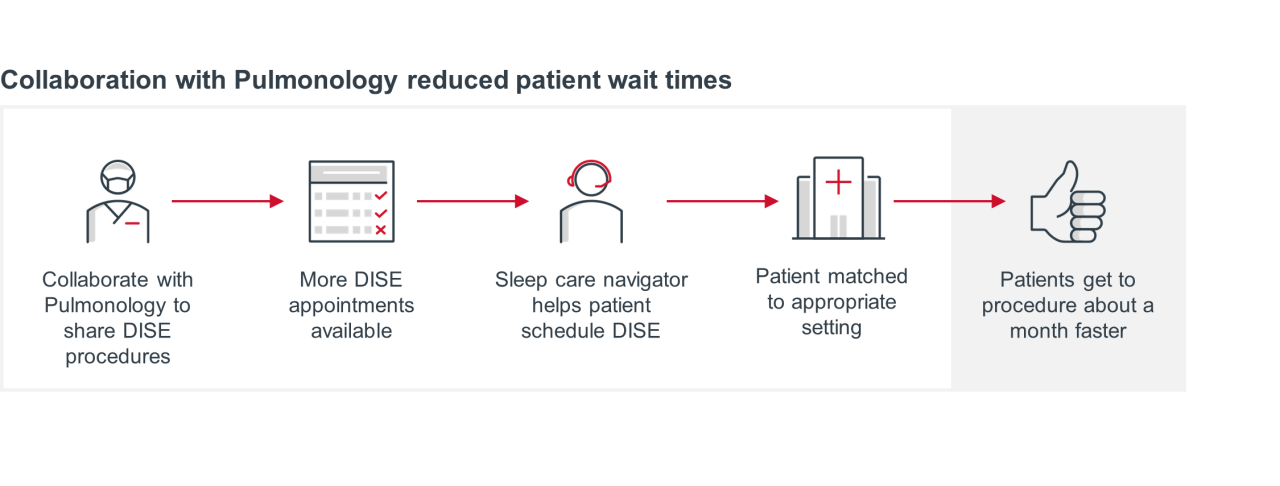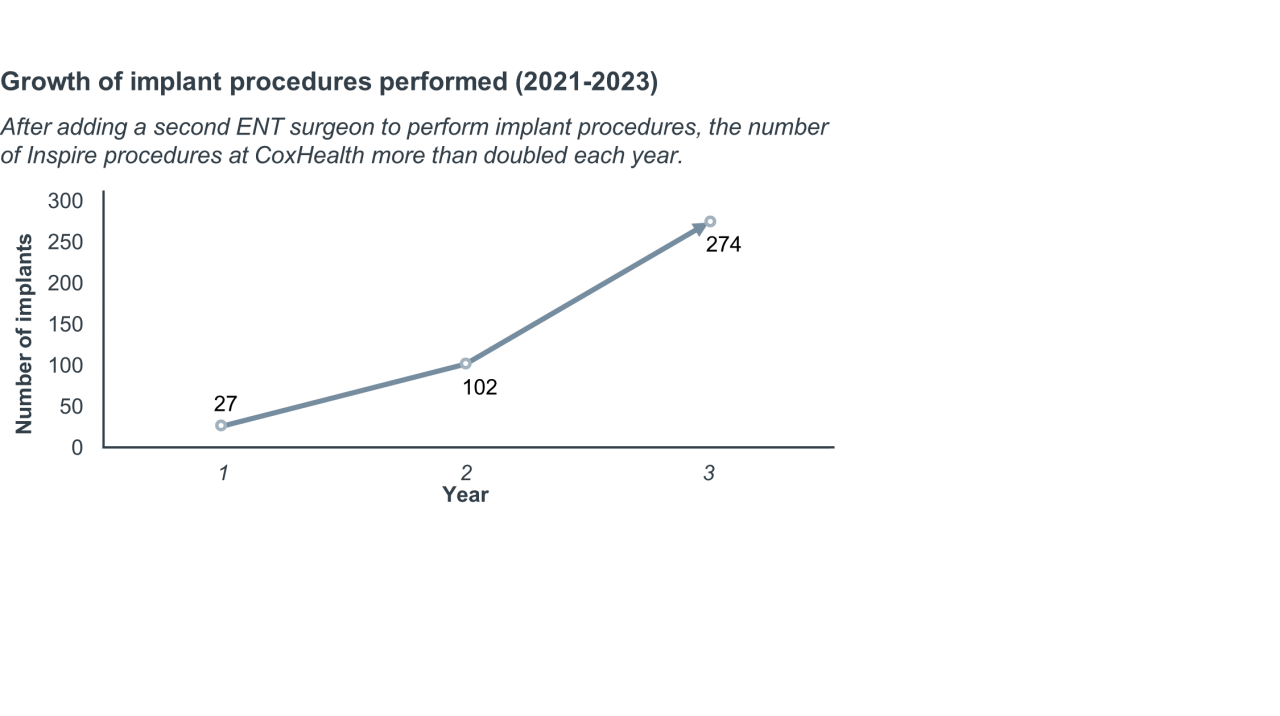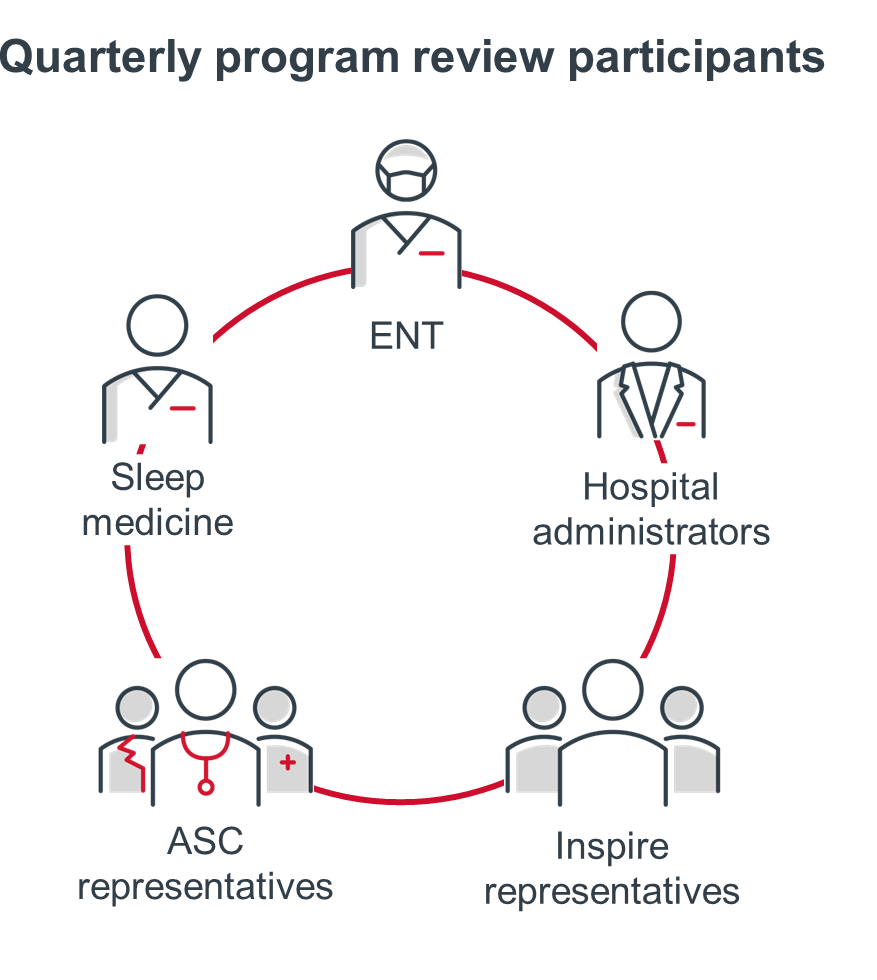The challenge
Since the launch of CoxHealth’s Inspire1 therapy program to treat obstructive sleep apnea (OSA), news about the procedure has spread quickly through word-of-mouth, referrals from other providers, and self-led patient awareness — all increasing patient demand. This large influx of patients stretched the capacity of CoxHealth’s surgical team, and the lengthy follow-up process sometimes led to patients becoming discouraged. CoxHealth needed strategies to build and optimize their program to keep interested and eligible patients engaged, increase efficiency, and allow for future growth.2
The organization
CoxHealth is the region's only locally-owned, not-for-profit health system with six hospitals, more than 80 clinics, five ERs, and nearly 12,000 employees throughout southwest Missouri. CoxHealth operates in a distinctive region, serving 25 counties spanning southwest Missouri and northwest Arkansas. Through its three sleep disorder centers, sleep lab, and sleep medicine services, CoxHealth treats a variety of sleep disorders, including sleep apnea, snoring, insomnia, and restless leg syndrome. Although CoxHealth isn’t in a major metropolitan area, their Inspire program is growing faster than programs in the most populous metro areas.
The approach
CoxHealth took a multi-pronged approach to retaining patients interested in Inspire, including developing and coordinating a robust sleep care program, optimizing the efficiency of the procedure, and maintaining high levels of collaboration across service lines. First, CoxHealth employed a sleep care navigator to coordinate high quality sleep care and ensure that patients are seen by the right provider before and after the procedure. Second, the organization reduced patient wait times by inviting pulmonologists to perform drug-induced endoscopies (DISE), which is essential to determining the eligibility of potential Inspire patients. Third, CoxHealth empowered a physician assistant (PA) in sleep medicine to launch and implement the Inspire program. As program champion, the PA continues to manage care and guide patients through the program. Finally, every quarter representatives across service lines review the program and strategize how to make it even better for patients, providers, and the health system, ensuring the program’s continued growth.
The result
CoxHealth’s whole-system, collaborative approach has resulted in high-quality care coordination that ensures patients are seen and treated as quickly as possible, preventing the loss of patients in the follow-up process. Building and developing sleep services has created a foundation for the Inspire program to be highly successful and poised for growth.
How CoxHealth grew their Inspire program to meet surging demand
CoxHealth took a multi-pronged approach to retaining patients interested in the Inspire procedure. This included ensuring high-quality care coordination, collaboration across service lines, and optimizing the efficiency of the implant procedure, leading to a better patient experience and continued program growth.
1. Maintain high-quality care coordination
Because of the high demand for the Inspire procedure, care coordination at CoxHealth has been especially important. If patients can’t see the right providers in a timely way, they may become discouraged with the lengthy implant process. CoxHealth did two things to optimize their sleep care pathway. First, they deployed a sleep care navigator within sleep medicine to coordinate care. Second, they enabled primary care physicians (PCPs) within the health system to submit electronic sleep care referrals so patients could more easily follow up with sleep medicine and related testing.
Whether or not they are candidates for Inspire, sleep care patients must navigate multiple service lines, testing, and ongoing follow-up to manage their condition — all of which can be confusing and overwhelming. Much like oncology patients who need designated help navigating complex cancer care, sleep care patients need guidance and support. Without that support, some patients may fall through the cracks, losing out on a potentially life-changing procedure.
At CoxHealth, the sleep care navigator performs a range of essential duties, from scheduling follow-up appointments to managing referrals from PCPs. Also, the navigator is trained to educate patients on using the remote that accompanies the Inspire device. Centralizing tasks with the navigator increases program efficiency, keeps patients connected throughout the implant process, and improves outcomes — creating time for additional device activations and consults.
Care coordination also helps to keep track of patients who aren’t initially eligible for Inspire. For some patients, nasal surgeries, such as septoplasty or rhinoplasty, oral surgeries, such as tonsillectomy, and weight management may alleviate sleep apnea symptoms — and some of these patients may eventually become eligible for Inspire therapy.

2. Reduce patient wait times by taking a collaborative approach to DISE between departments
On review of the Inspire process, CoxHealth realized that a lack of available appointments for drug-induced sleep endoscopies (DISE) — a procedure that allows providers to see which segments of OSA patients’ upper airway are collapsing during sleep3 — were causing uncomfortably long wait times for OSA patients, which significantly slowed patient access to implant therapy.
To reduce patient wait times and maximize efficiency, CoxHealth invited the pulmonology department to perform DISE for commercially insured patients. ENT continued to do the procedure for Medicare patients, because Medicare guidelines require DISE be performed by an otolaryngologist. The pulmonologists who perform DISE now have six to seven hours per week available in the endoscopy suite, and the increased availability of DISE appointments has shortened the timeline to the implant procedure by at least a month.
Week reduction in time from initial consult to Inspire implant due to process and scheduling improvements
Because CoxHealth fostered a positive relationship among sleep services, pulmonology, ENT, and the health system as a whole, it was easier to shift DISE cases between departments. Sleep services works with departments to avoid conflicts with the use of rooms or general anesthesia.
It is also easier for sleep services to coordinate where patients receive DISE. Patients without complex conditions, such as an underlying heart or lung condition, may undergo DISE in the ASC, while patients with complex conditions may need to be admitted to the hospital. Fortunately, both the ASC and the hospital setting can prioritize implant patients, offer flexible scheduling for appointments with ENT, and create blocks of time for back-to-back procedures.

3. Focus on patient experience and be prepared for growth
When CoxHealth was first considering the Inspire program, they found that system physicians didn’t have the capacity to champion a new program. Instead, a PA in pulmonology stepped up to champion the Inspire program’s implementation with a focus on making sure patients have a positive experience with the therapy. The PA also advocated for an efficient process approach. All implant patients are routed to sleep medicine before going to ENT, which ensures that all necessary testing is completed before the patient consults with the implant surgeon. She also:
- Dedicated time in the initial consult for prospective patients to ensure full understanding of the Inspire process.
- Worked closely with a sleep care navigator to improve scheduling processes for all patients.
- Advocated for Inspire to help improve the insurance pre-certification process for patients.
After seeing a 278% increase in Inspire patients in just one year, the PA realized that the program’s rapid growth required more resources. She shifted to managing Inspire care full-time, which expanded implant surgeons’ capacity: Time that surgeons would have spent managing the Inspire process could now be dedicated to procedures. She plays a vital role in patient care, guiding patients through the sleep study process, pre-screening for Inspire eligibility, and supporting post-implant care by managing implant activation and maintenance. CoxHealth also added a second surgical otolaryngologist to meet growing patient demand and is considering further expansion of the program.

4. Prioritize ongoing collaboration through quarterly program reviews
To ensure the success of the Inspire program, CoxHealth brought together specialties that hadn’t historically worked together. During a quarterly program review, representatives from sleep medicine, ENT, the ASC, hospital administration, and Inspire collaborate to set growth targets for the program, find ways to increase efficiency to meet those growth targets, and get ahead of potential roadblocks.
Aside from encouraging program cohesion, getting multiple service lines to collaborate consistently creates opportunities to improve processes. For example, when ENT providers realized how quickly the program was growing, they were able to secure more OR time with ASC staff at the review.
In fact, many of the strategies outlined in this case study were generated during quarterly program reviews. For example, during a discussion about process improvement and troubleshooting, the group realized that waiting for a DISE procedure, which was required to determine eligiblity for Inspire, was lengthening patient wait time more than any other point in the process. This realization led to CoxHealth inviting pulmonology to take on DISE for certain patients.

How we know it’s working
CoxHealth’s collaborative model has led to strong clinical outcomes, reduced wait times, improved patient retention, and continued program growth. Overall, these positive outcomes are driving CoxHealth’s outstanding reputation within the community.
Patients received the implant procedure over three years
Increase in implant volumes from 2022 to 2023 with the addition of a second surgeon
Average reduction in apnea-hypopnea index (AHI) scores after implant (from an average of 31.7 to 7.6)
Average point reduction in Epworth Sleepiness Scale (ESS) scores after implant (from an average of 10.3 to 5.8)
I had great assistance from the Inspire team, backing from the administration at CoxHealth, a supportive collaborating physician, and a fantastic ENT surgeon willing to implant — and now our dedicated sleep navigator. It takes a cohesive team to run a successful program, and we could not accomplish it without everyone involved believing in this process and this therapy.
Jennifer Fierke was the content writer on this case study.
Inspire Medical Systems, Inc., is a medical innovation company committed to the safe, effective, and reliable treatment of obstructive sleep apnea in order to improve patient lives.
Inspire® therapy is a solution for people with obstructive sleep apnea who have tried and struggled with CPAP. The Inspire® implant works inside the body to treat the root cause of OSA, enabling patients to breathe regularly and sleep soundly. Learn more at inspiresleep.com.
This report is sponsored by Inspire, an Advisory Board member organization. Representatives of Inspire helped select the topics and issues addressed. Advisory Board experts wrote the report, maintained final editorial approval, and conducted the underlying research independently and objectively. Advisory Board does not endorse any company, organization, product or brand mentioned herein.
To learn more, view our editorial guidelines.
1 The Inspire implant stimulates the hypoglossal nerve to keep the airway open during sleep.
2 Note: Unless otherwise specified, all information in this case study came from Advisory Board interviews with officials from CoxHealth.
3 Carrasco-Llatas, M, Matarredona-Quiles, S, De Vito, A, et al. Drug-Induced Sleep Endoscopy: Technique, Indications, Tips and Pitfalls. Healthcare. July 24, 2019.

This report is sponsored by Inspire. Advisory Board experts wrote the report, maintained final editorial approval, and conducted the underlying research independently and objectively.
Don't miss out on the latest Advisory Board insights
Create your free account to access 1 resource, including the latest research and webinars.
Want access without creating an account?
You have 1 free members-only resource remaining this month.
1 free members-only resources remaining
1 free members-only resources remaining
You've reached your limit of free insights
Become a member to access all of Advisory Board's resources, events, and experts
Never miss out on the latest innovative health care content tailored to you.
Benefits include:
You've reached your limit of free insights




